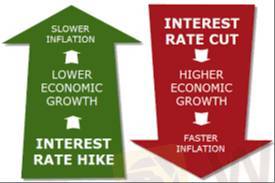
2025-02-18 01:29
IndustriyaUnderstanding Interest Rate and Forex Markets
firstdealofthenewyearastylz
The relationship between interest rates and foreign exchange (forex) markets is crucial in global finance. Here's how they interact:
1. Interest Rates and Currency Value
Interest rates directly impact currency value because they influence capital flows and investor behavior.
Higher Interest Rates → Stronger Currency
When a country raises interest rates, it attracts foreign investment because investors seek higher returns. This increases demand for the currency, causing appreciation.
Example: If the Federal Reserve raises U.S. interest rates, the USD strengthens as investors buy dollars to invest in U.S. assets.
Lower Interest Rates → Weaker Currency
Lower interest rates reduce the incentive for foreign investors, leading to capital outflows and depreciation of the currency.
Example: If the European Central Bank (ECB) cuts interest rates, the Euro (EUR) may weaken as investors shift to higher-yielding assets elsewhere.
2. Interest Rate Differentials and Carry Trade
Carry Trade Strategy
Traders borrow in a low-interest-rate currency and invest in a higher-interest-rate currency to profit from the rate differential.
Example: Borrowing Japanese Yen (JPY) (low rate) and investing in Australian Dollar (AUD) (higher rate).
If a central bank changes interest rates unexpectedly, it can disrupt carry trades and cause volatility.
3. Central Bank Policies and Market Reactions
Hawkish Policy (Rate Hike or Tighter Monetary Policy) → Currency Strengthens
Dovish Policy (Rate Cut or Loose Monetary Policy) → Currency Weakens
Forward Guidance (Central banks signaling future rate changes) can also move forex markets before actual rate changes.
4. Inflation, Interest Rates, and Forex
High inflation often leads to higher interest rates (to control inflation), strengthening the currency.
If inflation erodes purchasing power faster than interest rate hikes, the currency may still weaken.
5. Global Risk Sentiment & Safe-Haven Currencies
In times of economic uncertainty, investors move toward safe-haven currencies like the USD, CHF (Swiss Franc), or JPY regardless of interest rate trends.
Bottom Line
Interest rates are one of the most significant drivers of forex markets. Traders watch central banks like the Federal Reserve (Fed), ECB, Bank of Japan (BoJ), and Bank of England (BoE) closely for policy shifts.
Katulad 0

Vince024
Brokers
Mainit na nilalaman
Pagsusuri ng merkado
Dogecoin cheers coinbase listing as Bitcoin’s range play continues
Pagsusuri ng merkado
Grayscale commits to converting GBTC into Bitcoin ETF:
Pagsusuri ng merkado
Bitcoin's price is not the only number going up
Pagsusuri ng merkado
Theta Price Prediction:
Pagsusuri ng merkado
How to Research Stocks:
Pagsusuri ng merkado
Bitcoin (BTC), Ethereum (ETH) Forecast:
Kategorya ng forum

Plataporma

Eksibisyon

Ahente

pangangalap

EA

Industriya

Merkado

talatuntunan
Understanding Interest Rate and Forex Markets
 Hong Kong | 2025-02-18 01:29
Hong Kong | 2025-02-18 01:29firstdealofthenewyearastylz
The relationship between interest rates and foreign exchange (forex) markets is crucial in global finance. Here's how they interact:
1. Interest Rates and Currency Value
Interest rates directly impact currency value because they influence capital flows and investor behavior.
Higher Interest Rates → Stronger Currency
When a country raises interest rates, it attracts foreign investment because investors seek higher returns. This increases demand for the currency, causing appreciation.
Example: If the Federal Reserve raises U.S. interest rates, the USD strengthens as investors buy dollars to invest in U.S. assets.
Lower Interest Rates → Weaker Currency
Lower interest rates reduce the incentive for foreign investors, leading to capital outflows and depreciation of the currency.
Example: If the European Central Bank (ECB) cuts interest rates, the Euro (EUR) may weaken as investors shift to higher-yielding assets elsewhere.
2. Interest Rate Differentials and Carry Trade
Carry Trade Strategy
Traders borrow in a low-interest-rate currency and invest in a higher-interest-rate currency to profit from the rate differential.
Example: Borrowing Japanese Yen (JPY) (low rate) and investing in Australian Dollar (AUD) (higher rate).
If a central bank changes interest rates unexpectedly, it can disrupt carry trades and cause volatility.
3. Central Bank Policies and Market Reactions
Hawkish Policy (Rate Hike or Tighter Monetary Policy) → Currency Strengthens
Dovish Policy (Rate Cut or Loose Monetary Policy) → Currency Weakens
Forward Guidance (Central banks signaling future rate changes) can also move forex markets before actual rate changes.
4. Inflation, Interest Rates, and Forex
High inflation often leads to higher interest rates (to control inflation), strengthening the currency.
If inflation erodes purchasing power faster than interest rate hikes, the currency may still weaken.
5. Global Risk Sentiment & Safe-Haven Currencies
In times of economic uncertainty, investors move toward safe-haven currencies like the USD, CHF (Swiss Franc), or JPY regardless of interest rate trends.
Bottom Line
Interest rates are one of the most significant drivers of forex markets. Traders watch central banks like the Federal Reserve (Fed), ECB, Bank of Japan (BoJ), and Bank of England (BoE) closely for policy shifts.
Katulad 0
Gusto kong magkomento din
Ipasa
0Mga komento

Wala pang komento. Gawin ang una.

Ipasa
Wala pang komento. Gawin ang una.